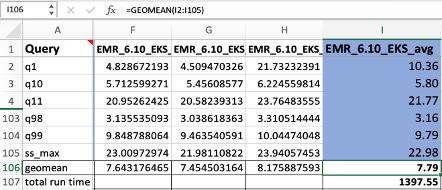Amazon EMR on EKS provides an implementation selection for Amazon EMR that allows firms to run open-source massive knowledge constructions on Amazon Elastic Kubernetes Carrier (Amazon EKS). With EMR on EKS, Glow programs paintings at the Amazon EMR runtime for Apache Glow. This performance-optimized runtime supplied via Amazon EMR makes your Glow duties run briefly and cost-effectively. Likewise, you’ll be able to run different types of group programs, corresponding to internet programs and synthetic intelligence (ML) TensorFlow paintings, on the very same EKS cluster. EMR on EKS streamlines your amenities control, takes complete good thing about useful resource utilization, and reduces your expense.
We’ve got if truth be told been repeatedly bettering the Glow potency in each and every Amazon EMR unlock to further cut back activity runtime and strengthen customers’ prices on their Amazon EMR massive knowledge paintings. For the reason that Amazon EMR 6.5 unlock in January 2022, the improved Glow runtime used to be 3.5 instances quicker than OSS Glow v3.1.2 with up to 61% decrease bills. Amazon EMR 6.10 is now 1.59 instances quicker than Amazon EMR 6.5, which has if truth be told led to five.37 instances a lot better potency than OSS Glow v3.3.1 with 76.8% expense financial savings.
On this submit, we give an explanation for the benchmark setup and effects on most sensible of the EMR on EKS setting. We likewise proportion a Glow same old provider that matches all Amazon EMR unlock choices, so you’ll be able to reproduce the process on your setting to your personal potency check circumstances. The provider makes use of the TPC-DS dataset and unmodified knowledge schema and desk relationships, on the other hand obtains inquiries from TPC-DS to beef up the SparkSQL check circumstances. It’s not very similar to different launched TPC-DS same old results.
Usual setup
To check to the EMR on EKS 6.5 check end result detailed within the submit Amazon EMR on Amazon EKS provides up to 61% decrease bills and up to 68% potency enhancement for Glow paintings, this same old for the newest unlock (Amazon EMR 6.10) makes use of the very same methodology: a TPC-DS same old construction and the very same measurement of TPC-DS enter dataset from an Amazon Easy Garage Carrier (Amazon S3) position. For the supply knowledge, we decided on the three TB scale facet, which incorporates 17.7 billion information, kind of 924 GB compressed knowledge in Parquet record layout. The setup instructions and technical knowledge may also be found out within the aws-sample repository
In abstract, the entire potency check activity is composed of 104 SparkSQL inquiries and used to be completed in kind of 24 mins (1,397.55 seconds) with an approximated operating expense of $5.08 USD. The enter knowledge and check end result outputs had been each stored on Amazon S3.
The duty has if truth be told been arrange with the next standards that fit with the former Amazon EMR 6.5 check:
- EMR unlock — EMR 6.10.0
- {Hardware}:
- Compute— 6 X c5d.9 xlarge instances, 216 vCPU, 432 GiB reminiscence in total
- Garage— 6 x 900 NVMe SSD build-in garage
- Amazon EBS root quantity— 6 X 20GB gp2
- Glow setup:
- Motorist pod— 1 instances to call a couple of 7 directors on a shared Amazon Elastic Compute Cloud (Amazon EC2) node:
spark.motive force.cores= 4spark.motive force.reminiscence= 5gspark.kubernetes.motive force.restrict.cores= 4.1
- Administrator pod— 47 instances dispersed over 6 EC2 nodes
spark.executor.cores= 4spark.executor.reminiscence= 6gspark.executor.memoryOverhead= 2Gspark.kubernetes.executor.restrict.cores= 4.3
- Motorist pod— 1 instances to call a couple of 7 directors on a shared Amazon Elastic Compute Cloud (Amazon EC2) node:
- Metadata store — We make the most of Glow’s in-memory knowledge brochure to save lots of metadata for TPC-DS databases and tables–
spark.sql.catalogImplementationis about to the default valuein-memoryThe truth tables are separated via the date column, which incorporates walls various from 200– 2,100. No stats are pre-calculated for those tables.
Results
A unmarried check consultation comprises 104 Glow SQL inquiries that had been run sequentially. We ran each and every Glow runtime consultation (EMR runtime for Apache Glow, OSS Apache Glow) three times. The Glow same old activity produces a CSV record to Amazon S3 that sums up the common, minimal, and optimal runtime for each and every non-public inquiry.
The process we compute the final same old results (geomean and the whole activity runtime) are based totally upon anticipated price. We take the imply of the common, minimal, and optimal worths in line with inquiry using the system of AVERAGE(), as an example AVERAGE( F2: H2) Then we take a geometrical imply of the standard column I via the system GEOMEAN( I2: I105) and AMOUNT( I2: I105) for the whole runtime.

Previously, we noticed that EMR on EKS 6.5 is 3.5 instances quicker than OSS Glow on EKS, and prices 2.6 instances much less. From this same old, we found out that the gap has if truth be told broadened: EMR on EKS 6.10 now provides a 5.37 instances potency enhancement normally and up to 11.61 instances enhanced potency for personal inquiries over OSS Glow 3.3.1 on Amazon EKS. From the operating expense standpoint, we see the really extensive lower via 4.three times.

The next chart unearths the potency enhancement of Amazon EMR 6.10 in comparison to OSS Glow 3.3.1 on the non-public inquiry degree. The X-axis unearths the identify of each and every inquiry, and the Y-axis unearths the whole runtime in seconds on logarithmic scale. Probably the most really extensive potency positive factors for 8 inquiries (q14a, q14b, q23b, q24a, q24b, this autumn, q67, q72) confirmed over 10 instances faster for the runtime.

Job expense estimate
The expense quote does now not constitute Amazon S3 garage, or PUT and GET calls for. The Amazon EMR on EKS uplift estimation is based totally upon the in line with hour billing information equipped via AWS Expense Explorer
- c5d.9 xlarge in line with hour price— $1.728
- Number of EC2 instances— 6
- Amazon EBS garage in line with GB-month — $0.10
- Amazon EBS gp2 root quantity — 20GB
- Job run time (hour) –.
- OSS Glow 3.3.1— 2.09
- EMR on EKS 6.5.0 — 0.68
- EMR on EKS 6.10.0 — 0.39
| Expense part | OSS Glow 3.3.1 on EKS | EMR on EKS 6.5.0 | EMR on EKS 6.10.0 |
| Amazon EC2 | $ 21.67 | $ 7.05 | $ 4.04 |
| EMR on EKS | $– | $ 1.57 | $ 0.99 |
| Amazon EKS | $ 0.21 | $ 0.07 | $ 0.04 |
| Amazon EBS root quantity | $ 0.03 | $ 0.01 | $ 0.01 |
| Total | $ 21.88 | $ 8.70 | $ 5.08 |
Potency enhancements
Even supposing we strengthen on Amazon EMR’s potency with each and every unlock, Amazon EMR 6.10 incorporated a lot of potency optimizations, making it 5.37 instances quicker than OSS Glow v3.3.1 and 1.59 instances quicker than our first actual unlock of 2022, Amazon EMR 6.5. This additional potency build up used to be attained during the addition of a number of optimizations, consisting of:
- Improvements to enroll with potency, corresponding to the next:.
- Shuffle-Hash Indicators Up With (SHJ) are extra CPU and I/O efficient than Shuffle-Kind-Merge Indicators up with (SMJ) when the bills of construction and penetrating the hash desk, consisting of the agenda of reminiscence, are lower than the expense of arranging and wearing out the mix enroll with. However, SHJs have disadvantages, corresponding to risk of out of reminiscence errors because of its failure to spill to disk, which avoids them from being strongly applied during Glow in location of SMJs via default. We’ve got if truth be told enhanced our utilization of SHJs in order that they may be able to be used to extra inquiries via default than in OSS Glow.
- For some inquiry shapes, we have now if truth be told gotten rid of redundant indicators up with and allowed applying extra performant enroll with varieties.
- We’ve got if truth be told diminished the amount of data blended previous to indicators up with and the capability for info surges after indicators up with via selectively decreasing aggregates via indicators up with.
- Blossom filters can strengthen potency via minimizing the amount of data blended previous to the enroll with. However, there are circumstances the place flower filters don’t seem to be helpful and may also fall again potency. As an example, the flower filter out gifts a dependence in between levels that decreases inquiry parallelism, on the other hand may finish up putting off quite little knowledge. Our enhancements permit flower filters to be securely used to extra inquiry methods than OSS Glow.
- Aggregates with high-precision decimals are computationally intensive in OSS Glow. We enhanced high-precision decimal calculations to expanding their potency.
Abstract
With variation 6.10, Amazon EMR has if truth be told much more boosted the EMR runtime for Apache Glow by contrast to our earlier same old checks for Amazon EMR variation 6.5. When operating EMR paintings with the the related Apache Glow variation 3.3.1, we noticed 1.59 instances a lot better potency with 41.6% more economical bills than Amazon EMR 6.5.
With our TPC-DS same old setup, we noticed a substantial potency spice up of five.37 instances and an expense lower of four.three times using EMR on EKS in comparison to OSS Glow.
For more info and start with EMR on EKS, take a look at the EMR on EKS Workshop and move to the EMR on EKS Greatest Practices Information web page
In regards to the Authors
 Song Yang is a Senior Large Information Carrier Fashion designer for Amazon EMR at AWS. She is a talented analytics chief coping with AWS purchasers to supply greatest observe help and technical ideas so as to assist their luck in knowledge growth. Her places of pursuits are open-source constructions and automation, knowledge engineering and DataOps.
Song Yang is a Senior Large Information Carrier Fashion designer for Amazon EMR at AWS. She is a talented analytics chief coping with AWS purchasers to supply greatest observe help and technical ideas so as to assist their luck in knowledge growth. Her places of pursuits are open-source constructions and automation, knowledge engineering and DataOps.
 Ashok Chintalapati is a instrument software development engineer for Amazon EMR at Amazon Internet Supplier.
Ashok Chintalapati is a instrument software development engineer for Amazon EMR at Amazon Internet Supplier.